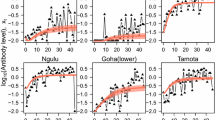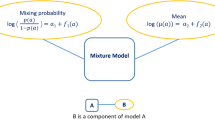Abstract
A model is developed to estimate the duration for which malaria antibody levels in the blood remain high in a closed population. This estimate can be used to calculate the transmission rate within a region, in conjunction with the serological information contained in the population. The model is used on data obtained from a study of malaria in the Philippines and shows excellent agreement. It is subsequently utilised for predictions and seems to be an appropriate vehicle for this purpose.
Similar content being viewed by others
References
Bruce-Chawatt, L., Dodge, J., Draper, C., Topley, E. and Voller, A.: Sero-epidemiological studies on population groups previously exposed to malaria. Lancet, 512–514 (1972)
Burattini, M., Massad, E. and Coutinho, F.: Malaria transmission rates estimated from serological data. Epidemiol. Infect.111, 503–523 (1993a)
Burattini, M., Massad, E., Coutinho, F. and Baruzzi, B.: Malaria prevalence amongst Brazilian Indians assessed by a new mathematical model. Epidemiol. Infect.111, 525–537 (1993b)
Cox, D. and Oakes, D.: Analysis of Survival Data, UK: Chapman and Hall (1984)
Diggs, C. and Sadun, E.: Serological cross-reactivity between Plasmodium vivax and Plasmodium falciparum as determined by a modified fluorescent antibody test. Experimental Parasitology16, 217–233, (1965)
Draper, C. and Voller, A.: The epidemiological interpretation of serological data in malaria. Am. J. Trop. Med. Hyg,21:5, 696–703 (1972)
Gatton, M.: Mathematical Modelling of the Dynamics of Malaria Antibody Levels in the Philippines. Honours Thesis, Griffith Uni., Aust. (1993)
Halloran, M. and Struchiner, C.: Modelling transmission dynamics of stage-specific malaria vaccines. Parasitology Today,8:3, 77–85 (1992)
Lee, E.: Statistical Methods for Survival Data Analysis, USA: Wiley (1992)
McWilson, W., Collins, W., Jeffery, G. and Shinner, J.: The sero epidemiology of malaria in Middle America II; Studies on the Pacific Coast of Costa Rica. Am. J. Trop. Med. Hyg.24:5, 749–754 (1975)
Molineaux, L. and Gramiccia, G.: The Garki Project: Research on the Epidemiology and Control of Malaria in the Sudan Savanna of West Africa, Chap 10: WHO (1980)
SAS Institute Inc.: SAS/STATTm Guide for Personal Computers, Version 6 Edition. USA: SAS Institute INC. (1987)
van Druten, J. and Meuwissen, J.: Models for long term retrospective analysis in seroepidemiology. World Health Organization Document WHO/MAL/81.970 (1981)
Author information
Authors and Affiliations
Rights and permissions
About this article
Cite this article
Gatton, M., Hogarth, W., Saul, A. et al. A model for predicting the transmission rate of malaria from serological data. J. Math. Biol. 34, 878–888 (1996). https://doi.org/10.1007/BF01834824
Received:
Accepted:
Issue Date:
DOI: https://doi.org/10.1007/BF01834824




